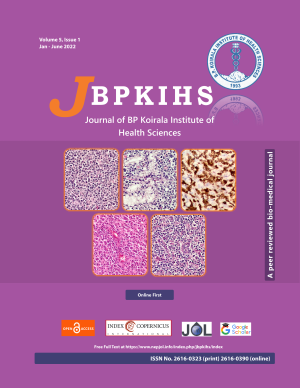An Audit of Management of Male Urethral Stricture and its Outcome: A Retrospective Review
DOI:
https://doi.org/10.3126/jbpkihs.v5i1.48452Keywords:
Anastomosis, Iatrogenic, Urethral Stricture , Male, TraumaticAbstract
Background: Urethral stricture leads to obstructive voiding dysfunction. We report an audit of surgical management of urethral stricture in adult males.
Methods: The records of all patients diagnosed with urethral stricture from December 2017 to March 2019 at B. P. Koirala Institute of Health Sciences, Nepal were retrieved. Preoperative, surgical, and postoperative follows-up data were evaluated. The American Urological Association International Prostatic Symptom Score (AUA-IPSS) and Uroflowmetry (voided volume and peak urinary flow rate (Qmax)) were used to assess the outcome of the surgery.
Results: Among 50 patients, the majority (46%) belonged to 40 - 59 years. Twenty-five patients (78.1%) with traumatic anterior urethral stricture underwent excision and primary end to end anastomotic (EPA) urethroplasty; seven patients (21.9%) with pelvic fracture urethral injury (PFUI) underwent progressive perineal urethroplasty (PPU) with EPA; eight patients with inflammatory urethral stricture underwent Kulkarni urethroplasty; four patients with iatrogenic urethral stricture underwent EPA; six patients with idiopathic urethral stricture underwent Barbagli dorsal onlay urethroplasty. All patients had preoperative voided volume < 150ml, Qmax < 15ml/s. Thirty patients had complete obliteration; the remaining patients had severe storage and voiding symptoms (AUA-IPSS ≥ 20) before surgery. Except for two patients who underwent redo surgery, outcome of urethroplasty was successful in terms of storage and voiding symptoms (AUA-IPSS < 7) and uroflometry findings (voided volume > 150ml and Qmax >15ml/s).
Conclusion: Urethreal stricture was most common in the age group of 40 - 59 years and traumatic stricture was the most common cause.
Downloads
Downloads
Published
How to Cite
Issue
Section
License
Copyright (c) 2022 Journal of BP Koirala Institute of Health Sciences

This work is licensed under a Creative Commons Attribution-NonCommercial-NoDerivatives 4.0 International License.
This license enables reusers to copy and distribute the material in any medium or format in unadapted form only, for noncommercial purposes only, and only so long as attribution is given to the creator.




